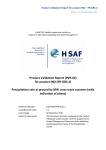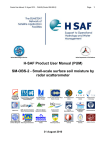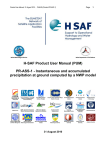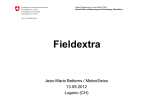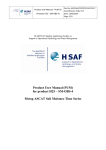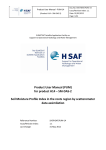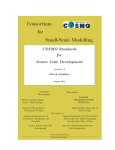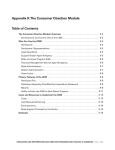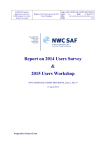Download Product User Manual (PUM) for product H15A – PR-OBS - H-SAF
Transcript
Product User Manual - PUM-15A (Product H15A - PR-OBS-06A) Doc.No: SAF/HSAF/PUM-15A Issue/Revision Index: 1.1 Date: 10/04/2015 Page: 1/22 EUMETSAT Satellite Application Facility on Support to Operational Hydrology and Water Management Product User Manual (PUM) for product H15A – PR-OBS-6A Blended SEVIRI Convection area/ LEO MW Convective Precipitation Reference Number: Issue/Revision Index: Last Change: SAF/HSAF/PUM-15A 1.1 10 Apr 2015 Product User Manual - PUM-15A (Product H15A - PR-OBS-06A) Doc.No: SAF/HSAF/PUM-15A Issue/Revision Index: 1.1 Date: 10/04/2015 Page: 2/22 DOCUMENT CHANGE RECORD Issue / Revision Date Description 1.0 02/03/2015 Baseline version prepared for ORR1 Part 5. 1.1 10/04/2015 Revised version which acknowledges the outcomes of ORR1 Part5: Inclusion of product accuracy information in section 4.1.2 (RID 01) Product User Manual - PUM-15A (Product H15A - PR-OBS-06A) Doc.No: SAF/HSAF/PUM-15A Issue/Revision Index: 1.1 Date: 10/04/2015 Page: 3/22 INDEX 1 2 Purpose of the document ......................................................................................................................... 5 Introduction to product PR-OBS-6A .......................................................................................................... 5 2.1 Principle of sensing ............................................................................................................................ 5 2.2 Status of satellites and instruments .................................................................................................. 6 2.3 Highlights of the algorithm ................................................................................................................ 7 2.4 Architecture of the products generation chain ................................................................................. 8 2.5 Product coverage and appearance .................................................................................................... 9 3 Product operational characteristics ........................................................................................................ 11 3.1 Horizontal resolution and sampling ................................................................................................ 11 3.1.1 Vertical resolution if applicable ............................................................................................... 11 3.1.2 Observing cycle and time sampling ......................................................................................... 11 3.1.3 Timeliness ................................................................................................................................ 11 4 Product validation ................................................................................................................................... 11 5 Product availability.................................................................................................................................. 13 5.1 Terms of Use .................................................................................................................................... 13 5.2 General Information ........................................................................................................................ 13 5.3 Formats and codes .......................................................................................................................... 13 5.4 Description of the files .................................................................................................................... 13 Annex 1: PR-OBS-6A output description ......................................................................................................... 15 Annex 2: Introduction to H-SAF ....................................................................................................................... 18 The EUMETSAT Satellite Application Facilities ............................................................................................ 18 Purpose of the H-SAF .................................................................................................................................. 19 Products / Deliveries of the H-SAF .............................................................................................................. 20 System Overview ......................................................................................................................................... 20 Annex 3: Acronyms .......................................................................................................................................... 21 Product User Manual - PUM-15A (Product H15A - PR-OBS-06A) Doc.No: SAF/HSAF/PUM-15A Issue/Revision Index: 1.1 Date: 10/04/2015 Page: 4/22 List of Tables Table 1 - Current status of satellites potentially utilised for PR-OBS-6A .................................................................... 6 Table 2 - Main features of SEVIRI ......................................................................................................................... 7 Table 3: Summary instructions for accessing PR-OBS-6A data ....................................................................... 14 List of Figures Figure 1 - The H-SAF required coverage in the Meteosat projection ......................................................................... 5 Figure 2 - Flow chart of the LEO/MW-GEO/IR-blending precipitation rate processing chain........................... 8 Figure 3 ocessing area - Meteosat-9, day 03 Feb 2008, time 08:15 UTC ........................................................................................................................................ 9 Figure 4 - Example of PR-OBS-6A product, 2014-12-03 23:57 UTC ................................................................. 10 Figure 5 - Structure of the Precipitation products validation team ................................................................ 12 Figure 6: Conceptual scheme of the EUMETSAT Application Ground Segment ............................................. 18 Figure 7: Current composition of the EUMETSAT SAF Network ..................................................................... 19 Product User Manual - PUM-15A (Product H15A - PR-OBS-06A) Doc.No: SAF/HSAF/PUM-15A Issue/Revision Index: 1.1 Date: 10/04/2015 Page: 5/22 1 Purpose of the document Product User Manuals are available for each (pre)-operational H-SAF product, for open users, and also for demonstrational products, as necessary for beta-users. Each PUM contains: Product introduction: principle of sensing, Satellites utilized, Instrument(s) description, Highlights of the algorithm, Architecture of the products generation chain, Product coverage and appearance; Main product operational characteristics: Horizontal resolution and sampling, Observing cycle and time sampling, Timeliness; Overview of the product validation activity: Validation strategy, Global statistics, Product characterisation; Basic information on product availability: Access modes, Description of the code, Description of the file structure. An annex also provides general information on H-SAF. 2 Introduction to product H15 - PR-OBS-6A 2.1 Principle of sensing Product H15 - PR-OBS-6A is based on the IR images from the SEVIRI instrument onboard Meteosat satellites. The whole H-SAF area is covered (see Figure 1), but the resolution degrades with latitude. An objective analysis of the equivalent blackbody temperatures (TBB) is implemented to detect the convective structures of cloudy areas, by means of NEFODINA, an automatic tool running at CNMCA dedicated to now-casting applications. A map of convective clouds is performed to combine precipitation fields from MW instruments (retrieved in H-SAF: PR-OBS-1 and PR-OBS-2A products). The product is generated at the 15-min imaging rate of SEVIRI, and the spatial resolution is consistent with the SEVIRI pixel. Figure 1 - The H-SAF required coverage in the Meteosat projection The delay is in the range of 3 to 5 minutes with a potential maximum of 10, after end of reception of whole disk SEVIRI data at CNMCA. Processing duration is principally dominated by convection identification algorithm. The more is HSAF area affected by convection areas the more is processing time to analyze the whole scene. The processing method is called “Rapid Update” and in H15 - PR-OBS-6A is applied only to convective structures.. The SEVIRI channels utilised for convective area identification are 6.2, 7.3 and 10.8 m. The calibration of TBB’s in term of precipitation rate by means of MW measurements (supposedly accurate) implies the existence of good correlation between TBB and precipitation rate. This is fairly acceptable for convective precipitation, less for non-convective. Nevertheless, Rapid Update is currently the only operational algorithm enabling precipitation rate estimates with the time resolution required for nowcasting. In addition, frequent sampling is a prerequisite for computing accumulated precipitation (product PR-OBS-5A and PR-OBS-5B). Doc.No: SAF/HSAF/PUM-15A Issue/Revision Index: 1.1 Date: 10/04/2015 Page: 6/22 Product User Manual - PUM-15A (Product H15A - PR-OBS-06A) 2.2 Status of satellites and instruments H15 - PR-OBS-6A does not retrieve precipitation from MW sensors. MW-derived precipitation data come from SSM/I and SSMIS (utilised by PR-OBS-1), and AMSU-A and MHS (utilised by PR-OBS-2A). The current status of the satellites possibly to be utilised for PR-OBS-6A is shown in Table 1 Two parallel operational chains are defined. In the first chain only the products of PR-OBS-2 are considered as input to H15A - PR-OBS-6A, because of the delay in receiving the SSM/I data via EUMETCAST. The second processing chain is running with a delay of 3 hours to include the PR-OBS-1 outputs in the RU processing was built. By using PR-OBS-1 in addition to PR-OBS-2A, thus improving the frequency of look-up table updating the accuracy of PR-OBS-6A is expected to improve. Satellite Launch DMSP-F15 (*) DMSP-F16 (*) DMSP-F17 (*) DMSP-F18 (*) MetOp A (**) NOAA-18 NOAA-19 Meteosat-9 12 Dec 1999 18 Oct 2003 4 Nov 2006 18 Oct 2009 19 Oct 2006 20 May 2005 6 Feb 2009 21 Dec 2005 End of service Height LST Status expected expected expected expected expected expected expected expected 845 km 855 km 855 km 857 km 817 km 854 km 870 km GEO: 05:40 d 07:10 d 05:30 d 07:55 d 09:31 d 13:52 a 13:43 a 0° Secondary Operation Secondary Operation Primary Operation Primary Operation Operational Operational Operational Operational 2010 2010 2011 2014 2011 2011 2014 2019 Instruments for H15A - PROBS-6A SSM/I (defective) SSMIS SSMIS SSMIS AMSU-A (defective), MHS AMSU-A, MHS AMSU-A, MHS (defective) SEVIRI (*) Not yet used for PR-OBS-6A. (**) Currently not used, waiting for adapting the PR-OBS-2 software to handle the defect of one AMSU-A channel. Table 1 - Current status of satellites potentially utilised for H15A - PR-OBS-6A Table 2collects the main features of SEVIRI. As mentioned, SSM/I, SSMIS, AMSU-A and MHS are not directly entered in the H15A - PR-OBS-6A generation chain, thus are not described here. Descriptions of SSM/I and SSMIS, and of AMSU-A and MHS can be found in the Product User Manuals PUM-01 (on PR-OBS-1) and PUM-02A/B (on PR-OBS-2A/B) [Note: AMSU-B is no longer used for PR-OBS-2A/B]. SEVIRI Spinning Enhanced Visible Infra-Red Imager Satellites Status Mission Instrument type Meteosat-8, Meteosat-9, Meteosat-10, Meteosat-11 (i.e., Meteosat Second Generation) Operational - Utilised in the period: 2002 to ~ 2021 Multi-purpose imagery and wind derivation by tracking clouds and water vapour features Multi-purpose imaging VIS/IR radiometer - 12 channels (11 narrow-bandwidth, 1 high-resolution broadbandwidth VIS) N/A (GEO) Full disk every 15 min. Limited areas in correspondingly shorter time intervals 4.8 km IFOV, 3 km sampling for narrow channels; 1.4 km IFOV, 1 km sampling for broad VIS channel Mass: 260 kg - Power: 150 W - Data rate: 3.26 Mbps Scanning technique Coverage/cycle Resolution (s.s.p.) Resources Central wavelength N/A (broad bandwidth channel) 0.635 µm 0.81 µm 1.64 µm 3.92 µm 6.25 µm 7.35 µm 8.70 µm 9.66 µm Spectral interval (99 % encircled energy) 0.6 - 0.9 µm 0.56 - 0.71 µm 0.74 - 0.88 µm 1.50 - 1.78 µm 3.48 - 4.36 µm 5.35 - 7.15 µm 6.85 - 7.85 µm 8.30 - 9.10 µm 9.38 - 9.94 µm Radiometric accuracy (SNR or NEΔT) 4.3 @ 1 % albedo 10.1 @ 1 % albedo 7.28 @ 1 % albedo 3 @ 1 % albedo 0.35 K @ 300 K 0.75 K @ 250 K 0.75 K @ 250 K 0.28 K @ 300 K 1.50 K @ 255 K Product User Manual - PUM-15A (Product H15A - PR-OBS-06A) 10.8 µm 12.0 µm 13.4 µm 9.80 - 11.8 µm 11.0 - 13.0 µm 12.4 - 14.4 µm Table 2 - Main features of SEVIRI Doc.No: SAF/HSAF/PUM-15A Issue/Revision Index: 1.1 Date: 10/04/2015 Page: 7/22 0.25 K @ 300 K 0.37 K @ 300 K 1.80 K @ 270 K 2.3 Highlights of the algorithm The baseline algorithm for H15A - PR-OBS-6A processing is described in ATBD-06A. Only essential elements are highlighted here. The blending technique adopted for H15A - PR-OBS-6A is called “Rapid Update (RU)”; see, for instance, Turk et al. 20001. Key to the RU blended satellite technique is a real time, underlying collection of time and space-intersecting pixels from operational geostationary IR imagers and LEO MW sensors. Rain intensity maps derived from MW measurements are used to create global, geo-located rain rate (RR) and TBB (equivalent blackbody temperature) relationships that are renewed as soon as new co-located data are available from both geostationary and MW instruments. The association of MW retrieved rain rate and the SEVIRI TBB is performed only within the part of clouds that NEFODINA individuate in the growing, mature and dissipating convective cell. In the software package these relationships are called histograms. To the end of geo-locating histogram relationships, the globe (or the study area) is subdivided in equally spaced lat-lon boxes (2.5°×2.5°). As new input datasets (MW and IR) are available in the processing chain, the MWderived rain rate pixels are paired with their time and space-coincident geostationary 10.8-µm IR TBB data, using a 15-minute maximum allowed time offset between the pixel observation times. The main inputs to the RU procedure are: geo-located equivalent blackbody temperatures (TBB) observed by the GEO platform and auxiliary data (e.g. cloud type and cloud top height); H-SAF dedicated NEFODINA data; rain-rate maps that, in principle, can arise from any satellite-based MW data and algorithm; observation geometry (satellite zenith angle). The package can be subdivided into five main parts, namely: 1) pre-processing: preparation and pre-processing of GEO data; ingest of rain rate maps at the LEO space-time resolution. To allow the proper initialization of the statistical relationships the input data must be collected for a time window that start several hours before the study period. According to the present constellation of MW-equipped satellites, the parameter MAXHOURS is currently set to 24 h; 2) co-location: co-located GEO and LEO observations are collected for the selected study area and accumulated from oldest to newest; 3) Convective Objects selection: process able to retrieve suitable NEFODINA information, to identify the Convective Objects (CO) on GEO data. 4) set-up of geo-located statistical relationships applying the probability matching technique only on to identified CO; 5) assign rain rate to each GEO pixel: production of rain-rate maps at the GEO space-time resolution. The rain rate are calibrated applying a calibration formula with coefficients derived from a statistical analysis applied to a dataset of H15A - PR-OBS-6A products and radar data. 1 Turk J.F., G. Rohaly, J. Hawkins, E.A. Smith, F.S. Marzano, A. Mugnai and V. Levizzani, 2000: “Analysis and assimilation of rainfall from blended SSMI, TRMM and geostationary satellite data”. Proc. 10th AMS Conf. Sat. Meteor. and Ocean., 9, 66-69. Product User Manual - PUM-15A (Product H15A - PR-OBS-06A) Doc.No: SAF/HSAF/PUM-15A Issue/Revision Index: 1.1 Date: 10/04/2015 Page: 8/22 2.4 Architecture of the products generation chain The architecture of the H15A - PR-OBS-6A product generation chain is shown in Figure 2 SSM/I-SSMIS ~ 3-hourly sequence of MW observations AMSU-MHS Lookup tables updating SEVIRI 15-min images NEFODINA CO Morphing algorithm PRECIPITATION RATE Rapid-update algorithm Extraction of dynamical info Figure 2 - Flow chart of the LEO/MW-GEO/IR-blending precipitation rate processing chain. Indeed, Figure 2 refers to the architecture of the product H15A - PR-OBS-6A that includes: the Rapid Update process, applied on to NEFODINA CO and based on (frequent) SEVIRI IR images “calibrated” by the (infrequent) MW-derived precipitation data as retrieved from SSM/1 and SSMIS (PR-OBS-1) or from AMSU-A and MHS (PR-OBS-2A). PR-OBS-1 microwave products are available with a delay of three hours as input of the second processing chain; the Morphing process, applied on to NEFODINA CO and based on (infrequent) MW-derived precipitation maps, and MW precipitation pseudo-maps interpolated at frequent intervals by exploiting the dynamic information provided by the SEVIRI images. Product User Manual - PUM-15A (Product H15A - PR-OBS-06A) Doc.No: SAF/HSAF/PUM-15A Issue/Revision Index: 1.1 Date: 10/04/2015 Page: 9/22 2.5 Product coverage and appearance Figure 3 shows a SEVIRI image, in its native projection, and the processing area of product H15A - PR-OBS6A. Figure 3 - SEVIRI image - Meteosat-9, day 03 Feb 2008, time 08:15 UTC The input area includes 900 lines x 1900 columns, from 70°N southwards. However, the algorithm stops processing above 67.5°N, thus does not cover the full H-SAF area (it could, but the product quality would sharply deteriorate). Product User Manual - PUM-15A (Product H15A - PR-OBS-06A) Doc.No: SAF/HSAF/PUM-15A Issue/Revision Index: 1.1 Date: 10/04/2015 Page: 10/22 Since data are delivered coded (in GRIB2) as values in grid points of known coordinates (those of the SEVIRI pixels), the product can be plotted in any projection of user’s choice. The example of product shown in Figure 4 is in the projection actually used in the .png files on the web site, rectangular stereography centred on 42°N, 10°E. The represented area is a fraction of the total processed area. Obviously, the map sequences are generally visualised as animations at 15-min intervals. Figure 4 - Example of H15A - PR-OBS-6A product, 2014-12-03 23:57 UTC Product User Manual - PUM-15A (Product H15A - PR-OBS-06A) Doc.No: SAF/HSAF/PUM-15A Issue/Revision Index: 1.1 Date: 10/04/2015 Page: 11/22 3 Product operational characteristics 3.1 Horizontal resolution and sampling The horizontal resolution ( x) is the convolution of several features (sampling distance, degree of independence of the information relative to nearby samples). To simplify matters, it is generally agreed to refer to the sampling distance between two successive product values, assuming that they carry forward reasonably independent information. The horizontal resolution descends from the instrument Instantaneous Field of View (IFOV), sampling distance (pixel), Modulation Transfer Function (MTF) and number of pixels to co-process for filtering out disturbing factors (e.g. clouds) or improving accuracy. It may be appropriate to specify both the resolution x associated to independent information, and the sampling distance, useful to minimise aliasing problems when data have to undertake resampling (e.g., for coregistration with other data). The IFOV of SEVIRI images is 4.8 km at nadir, and degrades moving away from nadir, becoming about 8 km in the H-SAF area. A figure representative of the H15A - PR-OBS-6A resolution is: x ~ 8 km. Sampling is made at ~ 5 km intervals, consistent with the SEVIRI pixel over Europe. 3.1.1 Vertical resolution if applicable The vertical resolution ( z) also is defined by referring to the vertical sampling distance between two successive product values, assuming that they carry forward reasonably independent information. The vertical resolution descends from the exploited remote sensing principle and the instrument number of channels, or spectral resolution. It is difficult to be estimated a-priori: it is generally evaluated a-posteriori by means of the validation activity. [Note: in H-SAF, the only product with vertical structure is SM-ASS-1, Volumetric soil moisture]. 3.1.2 Observing cycle and time sampling The observing cycle ( t) is defined as the average time interval between two measurements over the same area. In the case of H15A - PR-OBS-6A the product is generated soon after each SEVIRI new acquisition, Thus the observing cycle is t = 15 min and the sampling time also is 15 min. 3.1.3 Timeliness The timeliness ( ) is defined as the time between observation taking and product available at the user site assuming a defined dissemination mean. The timeliness depends on the satellite transmission facilities, the availability of acquisition stations, the processing time required to generate the product and the reference dissemination means. For H15A - PR-OBS-6A, the time of observations is 1-5 min before each quarter of an hour, ending at the full hour. To this, ~ 5 min have to be added for acquisition through EUMETCast and ~ 5 min for processing at CNMCA, thus: timeliness ~ 15 min. 4 Product validation 4.1.1 Quality assessment Whereas the previous operational characteristics have been evaluated on the base of system considerations (number of satellites, their orbits, access to the satellite) and instrument features (IFOV, swath, MTF and others), the evaluation of accuracy requires validation, i.e. comparison with the ground truth or with something assumed as “true”. H15A - PR-OBS-6A, as any other H-SAF product, is submitted to continuous quality assessment and validation activity entrusted to a number of institutes (see Figure 5). Product User Manual - PUM-15A (Product H15A - PR-OBS-06A) Doc.No: SAF/HSAF/PUM-15A Issue/Revision Index: 1.1 Date: 10/04/2015 Page: 12/22 Precipitation products validation group Leader: Italy (DPC) Belgium IRM Germany BfG Hungary OMSZ Italy UniFe Poland IMWM Slovakia SHMÚ Turkey ITU Figure 5 - Structure of the Precipitation products validation team Precipitation data are compared with rain gauges and meteorological radar. Before undertaking comparison, ground data and satellite data have been submitted to scaling and filtering procedures. Two streams of activities are carried out: evaluation of general statistics (multi-categorical and continuous), to help in identifying existence of pathological behaviour selected case studies, useful in identifying the roots of such behaviour. Detailed report of the product validation activity for product H15A - PR-OBS-6A is provided as following document: PVR-15A: Product Validation Report for H15A - PR-OBS-6A. 4.1.2 Product Accuracy User requirements for precipitation observation have been stated by authoritative entities such as WMO, EUMETSAT and the GPM planning group. Those requirements, acknowledging the fact that the accuracy of measuring precipitation from space depends on the precipitation type or, to simplify, intensity, are stated for three ranges of intensity: light: < 1 mm/h ; medium: 1 mm/h to 10 mm/h ; heavy: > 10 mm/h. It is noted that for the product H15 PR-OBS-6A, the type < 1 mm/h is not applicable. The following statistical scores are reported (for more information, see PVR-06A): RMSE (%): Root Mean Square Error expressed as % of the rain rate observed at station Table 3 summarizes the statistical scores obtained by the yearly validation of H15A with radar and rain gauge data . For the highest precipitation class H15A performs RMSE% slightly exceeds (inland) the threshold when compared with the radar observations, while it is in between threshold and target using the rain gauge for comparison. Regarding the intermediate precipitation class, i.e. 1<R<10 mm h-1, the RMSE% exceeds the threshold by more than 50%. H15A - PR-OBS-6A Annual average of RMSE% Precipitation Requirement (RMSE %) radar thresh target optimal land class 102% > 10 mm/h 90 80 25 gauge land radar coast 87% 104 % 319 % 262% 258% 1-10 mm/h 120 105 50 Table 3 Product requirement and compliance analysis for product H15A. Product User Manual - PUM-15A (Product H15A - PR-OBS-06A) Doc.No: SAF/HSAF/PUM-15A Issue/Revision Index: 1.1 Date: 10/04/2015 Page: 13/22 5 Product availability 5.1 Terms of Use All H-SAF products are owned by EUMETSAT, and the EUMETSAT SAF Data Policy applies. All intellectual property rights of the H-SAF products belong to EUMETSAT. The use of these products is granted to every interested user, free of charge. If you wish to use these products, EUMETSAT's copyright credit must be shown by displaying the words "copyright (year) EUMETSAT" on each of the products used. 5.2 General Information To access the H-SAF products the user must register at the H-SAF Official Web Portal http://hsaf.meteoam.it/ from which it is possible to access to the “H-SAF Product Download Centre”, which allows users to access data as described here following. 1) Access to data produced in the last 60 days must be made by the Official H-SAF FTP server ftp://ftphsaf.meteoam.it (to obtain user and password, please submit registration form on H-SAF Official Web Portal or contact the help desk at [email protected]) and via EUMETCAST, a multiservice dissemination system based on standard Digital Video Broadcast (DVB) technology (for more information http://www.eumetsat.int/). 2) The access to the archived data must be performed through an order process. There are two ways to place an order: a. the first (link) is a basic function provided directly from the H-SAF Web Portal. It provides all basic functions to carry out orders by selecting one or more products and setting for each selected product an expected time range; b. the second function https://eoportal.eumetsat.int/ allows access to EUMETSAT Data Centre. A registration to EUMETSAT portal is required. The EUMETSAT Data Center offers advanced functions of management and control of orders, among which the possibility to make geographical selection of products, to make the cloning of orders, and to monitor the status of the orders. In Both cases the orders placed will be submitted for approval and will be delivered within three working days. Finally, quick-looks of the latest 20 maps can be viewed as PNG images or as an animated slideshow on the H-SAF Web Portal. 5.3 Formats and codes Two type of files are provided for H15A - PR-OBS-6A: the digital data, coded in GRIB2 the image-like maps, coded in PNG In the directory “utilities”, the folder Grib_decode provides the instructions for reading the digital data. 5.4 Description of the files Product H15A - PR-OBS-6A Blended SEVIRI Convection area / LEO MW Convective Precipitation. It is also identified as H15A product of the H-SAF product list. The table below shows the detailed information to access the product using the H-SAF FTP server (ftp://ftphsaf.meteoam.it). Product User Manual - PUM-15A (Product H15A - PR-OBS-06A) Doc.No: SAF/HSAF/PUM-15A Issue/Revision Index: 1.1 Date: 10/04/2015 Page: 14/22 H15A - PR-OBS-6A Data Description Content: Blended SEVIRI Convection area / LEO MW Convective Precipitation Repository root directory: ftp://ftphsaf.meteoam.it/products/h15 Naming convention description: yyyymmdd: year, month, day hhmm: hour and minute of last scan line (northernmost) rom (fixed value): identifier of the receiving station, which is Rome Suffix for Digital Data: “grb.gz” (compressed GRIB file) and “qlt.grb.gz” (compressed GRIB file) Suffix for Image Data: “png” (image data file) H15A - PR-OBS-6A Digital Data Sub-repository /h15_cur_mon_grb (data of last 60 days) File name h15_yyyymmdd_hhmm_rom.grb.gz h15_yyyymmdd_hhMM_rom_qlt.grb.gzExample: ftp://ftphsaf.meteoam.it/products/h15/h15_cur_mon_grb/h15_20150209_2027_rom.grb.gz ftp://ftphsaf.meteoam.it/products/h15/h15_cur_mon_grb/h15_20150209_2027_rom_qlt.grb.gz H15A - PR-OBS-6A Image Data Sub-repository /h15_cur_mon_png (data of last 60 days) File name H15_yyyymmdd_hhmm_rom.png Example: ftp://ftphsaf.meteoam.it/products/h15/h15_cur_mon_png/h15_20150209_2042_rom.png Table 4: Summary instructions for accessing H15A - PR-OBS-6A data Product User Manual - PUM-15A (Product H15A - PR-OBS-06A) Doc.No: SAF/HSAF/PUM-15A Issue/Revision Index: 1.1 Date: 10/04/2015 Page: 15/22 Annex 1: H15A - PR-OBS-6A output description Product H15A - PR-OBS-6A (Blended SEVIRI Convection area/ LEO MW Convective Precipitation) is based on the SEVIRI instrument on board Meteosat Second Generation satellites. Main operational characteristics are connected with the identification of convection and the association of MW retrieved rain rate present in the same area with only active SEVIRI pixels, this by recomposing rain intensity that the system as in input from PR-OBS-1 and PR-OBS-2 towards the only part of clouds that NEFODINA individuate in the growing, mature and dissipating convective cell. It is encoded as a GRIB2 (please refer to WMO GRIB2 format documentation available at www.wmo.int), with the following keys: GRIB2 /* gribSection0 */ /* 3 = Space products (grib2/0.0.table) */ discipline,3 editionNumber,2 /* section 1 */ /* 80 = Rome (RSMC) (grib1/0.table) */ identificationOfOriginatingGeneratingCentre,80 identificationOfOriginatingGeneratingSubCentre,0 /* 3 = Current operational version number implemented on 2 November 2005 (grib2/1.0.table) */ gribMasterTablesVersionNumber,3 /* 0 = Local tables not used (grib2/1.1.table) */ versionNumberOfGribLocalTables,0 /* 3 = Observation time (grib2/1.2.table) */ significanceOfReferenceTime,3 /* 3 = Observation time (grib2/1.2.table) */ significanceOfReferenceTime,3 year, month, day, hour, minute, second, /* 1 = Operational test products (grib2/1.3.table) */ productionStatusOfProcessedData,1 /* 6 = Processed satellite observations (grib2/1.4.table) */ typeOfProcessedData,6 /* 0 = Specified in Code table 3.1 (grib2/3.0.table) */ sourceOfGridDefinition", numberOfDataPoints,1710000 numberOfOctetsForOptionalListOfNumbersDefiningNumberOfPoints,0 /* 0 = There is no appended list (grib2/3.11.table) */ interpretationOfListOfNumbersDefiningNumberOfPoints,0 /* 90 = Space view perspective orthographic (grib2/3.1.table) */ gridDefinitionTemplateNumber,90 /* 3 = Earth assumed oblate spheroid with major and minor axes specified by data producer (grib2/3.2.table) */ shapeOfTheEarth,3 scaleFactorOfRadiusOfSphericalEarth,0 scaledValueOfRadiusOfSphericalEarth,0 scaleFactorOfMajorAxisOfOblateSpheroidEarth,4 scaledValueOfMajorAxisOfOblateSpheroidEarth,63781400 scaleFactorOfMinorAxisOfOblateSpheroidEarth,4 scaledValueOfMinorAxisOfOblateSpheroidEarth,63567550 numberOfPointsAlongXAxis,1900 numberOfPointsAlongYAxis,900 latitudeOfSubSatellitePoint,0 longitudeOfSubSatellitePoint,0 Product User Manual - PUM-15A (Product H15A - PR-OBS-06A) Doc.No: SAF/HSAF/PUM-15A Issue/Revision Index: 1.1 Date: 10/04/2015 Page: 16/22 /* 0 = 00000000 (3=0) i direction increments not given (4=0) j direction increments not given (5=0) Resolved u- and v- components of vector quantities relative to easterly and northerly directions See grib2/3.3.table */ resolutionAndComponentFlags,0 apparentDiameterOfEarthInGridLengthsInXDirection",3622 apparentDiameterOfEarthInGridLengthsInYDirection",3568 xCoordinateOfSubSatellitePoint",764000 yCoordinateOfSubSatellitePoint",1774000 /* 0 = 00000000 (1=0) Points of first row or column scan in the +i (+x) direction (2=0) Points of first row or column scan in the -j (-y) direction (3=0) Adjacent points in i (x) direction are consecutive (4=0) All rows scan in the same direction See grib2/3.4.table */ scanningMode,0 orientationOfTheGrid,0 altitudeOfTheCameraFromTheEarthSCenterMeasuredInUnitsOfTheEarth,6610700 xCoordinateOfOriginOfSectorImage,0 yCoordinateOfOriginOfSectorImage,0 /* grib 2 Section 4 PRODUCT DEFINITION SECTION */ numberOfCoordinatesValues,0 /* 30 = Satellite product (grib2/4.0.table) */ productDefinitionTemplateNumber,30 /* 1 = Quantitative products (grib2/4.1.3.table) */ parameterCategory,1 /* 0 = Estimated precipitation (kg m-2) (grib2/4.2.3.1.table) */ parameterNumber,0 /* 8 = Observation (grib2/4.3.table) */ typeOfGeneratingProcess,8 observationGeneratingProcessIdentifier,3 numberOfContributingSpectralBands,1 /* grib 2 Section 5 DATA REPRESENTATION SECTION */ numberOfValues,1710000 /* 0 = Grid point data - simple packing (grib2/5.0.table) */ dataRepresentationTemplateNumber,0 decimalScaleFactor,0 numberOfBitsContainingEachPackedValue,16 /* 0 = Floating point (grib2/5.1.table) */ typeOfOriginalFieldValues,0 /* grib 2 Section 6 BIT-MAP SECTION */ /* 0 = Bit map is present in this product (grib2/6.0.table) */ bitMapIndicator,0 missingValue,0.0 /* grib 2 Section 7 data */ /* grib 2 Section 8 END */ The quality flag of PR-OBS6A output is encoded as a GRIB2 (please refer to WMO GRIB2 format documentation available at www.wmo.int), with the following keys: GRIB { # Space products (grib2/tables/3/0.0.table) discipline = 3; editionNumber = 2; # Rome (RSMC) (grib1/0.table) originatingCentre = 80; subCentre = 0; # Observation time (grib2/tables/3/1.2.table) significanceOfReferenceTime = 3; Product User Manual - PUM-15A (Product H15A - PR-OBS-06A) Doc.No: SAF/HSAF/PUM-15A Issue/Revision Index: 1.1 Date: 10/04/2015 Page: 17/22 dataDate = 20130228; dataTime = 2342; # Operational test products (grib2/tables/3/1.3.table) productionStatusOfProcessedData = 1; # Processed satellite observations (grib2/tables/3/1.4.table) typeOfProcessedData = 6; numberOfDataPoints = 1710000; # There is no appended list (grib2/tables/3/3.11.table) interpretationOfNumberOfPoints = 0; PLPresent = 0; # Space view perspective orthographic (grib2/tables/3/3.1.table) gridDefinitionTemplateNumber = 90; # Earth assumed oblate spheroid with major and minor axes specified by data producer (grib2/tables/3/3.2.table) shapeOfTheEarth = 3; Ni = 1900; Nj = 900; latitudeOfSubSatellitePointInDegrees = 0; longitudeOfSubSatellitePointInDegrees = 0; apparentDiameterOfEarthInGridLengthsInXDirection = 3622; apparentDiameterOfEarthInGridLengthsInYDirection = 3568; xCoordinateOfSubSatellitePoint = 764000; yCoordinateOfSubSatellitePoint = 1774000; iScansNegatively = 0; jScansPositively = 0; jPointsAreConsecutive = 0; alternativeRowScanning = 0; orientationOfTheGrid = 0; altitudeOfTheCameraFromTheEarthSCenterMeasuredInUnitsOfTheEarth = 6610700; xCoordinateOfOriginOfSectorImage = 0; yCoordinateOfOriginOfSectorImage = 0; typeOfGrid = space_view; NV = 0; # Satellite product (grib2/tables/3/4.0.table) productDefinitionTemplateNumber = 30; # Image format products (grib2/tables/3/4.1.3.table) parameterCategory = 0; # Unknown code table entry (grib2/tables/3/4.2.3.0.table) parameterNumber = 192; # Unknown code table entry (grib2/tables/3/4.3.table) typeOfGeneratingProcess = 192; observationGeneratingProcessIdentifier = 0; numberOfContributingSpectralBands = 0; numberOfValues = 135; typeOfPacking = grid_simple; # A bit map applies to this product and is specified in this Section (grib2/tables/3/6.0.table) bitMapIndicator = 0; bitmapPresent = 1 Product User Manual - PUM-15A (Product H15A - PR-OBS-06A) Doc.No: SAF/HSAF/PUM-15A Issue/Revision Index: 1.1 Date: 10/04/2015 Page: 18/22 Annex 2: Introduction to H-SAF The EUMETSAT Satellite Application Facilities H-SAF is part of the distributed application ground segment of the “European Organization for the Exploitation of Meteorological Satellites (EUMETSAT)”. The application ground segment consists of a “Central Application Facilities” located at EUMETSAT Headquarters, and a network of eight “Satellite Application Facilities (SAFs)”, located and managed by EUMETSAT Member States and dedicated to development and operational activities to provide satellite-derived data to support specific user communities (see Figure 6): Figure 6: Conceptual scheme of the EUMETSAT Application Ground Segment Figure 7, here following, depicts the composition of the EUMETSAT SAF network, with the indication of each SAF’s specific theme and Leading Entity. Product User Manual - PUM-15A (Product H15A - PR-OBS-06A) Doc.No: SAF/HSAF/PUM-15A Issue/Revision Index: 1.1 Date: 10/04/2015 Page: 19/22 Figure 7: Current composition of the EUMETSAT SAF Network Purpose of the H-SAF The main objectives of H-SAF are: a. to provide new satellite-derived products from existing and future satellites with sufficient time and space resolution to satisfy the needs of operational hydrology, by generating, centralizing, archiving and disseminating the identified products: precipitation (liquid, solid, rate, accumulated); soil moisture (at large-scale, at local-scale, at surface, in the roots region); snow parameters (detection, cover, melting conditions, water equivalent); b. to perform independent validation of the usefulness of the products for fighting against floods, landslides, avalanches, and evaluating water resources; the activity includes: downscaling/upscaling modelling from observed/predicted fields to basin level; fusion of satellite-derived measurements with data from radar and raingauge networks; assimilation of satellite-derived products in hydrological models; assessment of the impact of the new satellite-derived products on hydrological applications. Product User Manual - PUM-15A (Product H15A - PR-OBS-06A) Doc.No: SAF/HSAF/PUM-15A Issue/Revision Index: 1.1 Date: 10/04/2015 Page: 20/22 Products / Deliveries of the H-SAF For the full list of the Operational products delivered by H-SAF, and for details on their characteristics, please see H-SAF website hsaf.meteoam.it. All products are available via EUMETSAT data delivery service (EUMETCast, http://www.eumetsat.int/website/home/Data/DataDelivery/EUMETCast/index.html), or via ftp download; they are also published in the H-SAF website hsaf.meteoam.it. All intellectual property rights of the H-SAF products belong to EUMETSAT. The use of these products is granted to every interested user, free of charge. If you wish to use these products, EUMETSAT's copyright credit must be shown by displaying the words "copyright (year) EUMETSAT" on each of the products used. System Overview H-SAF is lead by the Italian Air Force Meteorological Service (ITAF USAM) and carried on by a consortium of 21 members from 11 countries (see website: hsaf.meteoam.it for details). Following major areas can be distinguished within the H-SAF system context: Product generation area; Central Services area (for data archiving, dissemination, catalogue and any other centralized services); Validation services area which includes Quality Monitoring/Assessment and Hydrological Impact Validation. Products generation area is composed of 5 processing centres physically deployed in 5 different countries; these are: for precipitation products: ITAF CNMCA (Italy); for soil moisture products: ZAMG (Austria), ECMWF (UK); for snow products: TSMS (Turkey), FMI (Finland). Central area provides systems for archiving and dissemination; located at ITAF CNMCA (Italy), it is interfaced with the production area through a front-end, in charge of product collecting. A central archive is aimed to the maintenance of the H-SAF products; it is also located at ITAF CNMCA. Validation services provided by H-SAF consists of: Hydrovalidation of the products using models (hydrological impact assessment); Product validation (Quality Assessment and Monitoring). Both services are based on country-specific activities such as impact studies (for hydrological study) or product validation and value assessment. Hydrovalidation service is coordinated by IMWM (Poland), whilst Quality Assessment and Monitoring service is coordinated by DPC (Italy): The Services’ activities are performed by experts from the national meteorological and hydrological Institutes of Austria, Belgium, Bulgaria, Finland, France, Germany, Hungary, Italy, Poland, Slovakia, Turkey, and from ECMWF. Product User Manual - PUM-15A (Product H15A - PR-OBS-06A) Doc.No: SAF/HSAF/PUM-15A Issue/Revision Index: 1.1 Date: 10/04/2015 Page: 21/22 Annex 3: Acronyms AMSU AMSU-A AMSU-B ATBD AU BfG CAF CDOP CESBIO CM-SAF CNMCA CNR CNRS DMSP DPC EARS ECMWF EDC EUM EUMETCast EUMETSAT FMI FTP GEO GRAS-SAF HDF HRV H-SAF © IDL IFOV IMWM IPF IPWG IR IRM ISAC ITU LATMOS LEO LSA-SAF LST Météo France METU MHS MSG MVIRI MW NEΔT NESDIS NMA NOAA NWC-SAF NWP NWP-SAF O3M-SAF OMSZ Advanced Microwave Sounding Unit (on NOAA and MetOp) Advanced Microwave Sounding Unit - A (on NOAA and MetOp) Advanced Microwave Sounding Unit - B (on NOAA up to 17) Algorithms Theoretical Baseline Document Anadolu University Bundesanstalt für Gewässerkunde (in Germany) Central Application Facility (of EUMETSAT) Continuous Development-Operations Phase Centre d'Etudes Spatiales de la BIOsphere (of CNRS, in France) SAF on Climate Monitoring Centro Nazionale di Meteorologia e Climatologia Aeronautica (in Italy) Consiglio Nazionale delle Ricerche (of Italy) Centre Nationale de la Recherche Scientifique (of France) Defense Meteorological Satellite Program Dipartimento Protezione Civile (of Italy) EUMETSAT Advanced Retransmission Service European Centre for Medium-range Weather Forecasts EUMETSAT Data Centre, previously known as U-MARF Short for EUMETSAT EUMETSAT’s Broadcast System for Environmental Data European Organisation for the Exploitation of Meteorological Satellites Finnish Meteorological Institute File Transfer Protocol Geostationary Earth Orbit SAF on GRAS Meteorology Hierarchical Data Format High Resolution Visible (one SEVIRI channel) SAF on Support to Operational Hydrology and Water Management Interactive Data Language Instantaneous Field Of View Institute of Meteorology and Water Management (in Poland) Institut für Photogrammetrie und Fernerkundung (of TU-Wien, in Austria) International Precipitation Working Group Infra Red Institut Royal Météorologique (of Belgium) (alternative of RMI) Istituto di Scienze dell’Atmosfera e del Clima (of CNR, Italy) İstanbul Technical University (in Turkey) Laboratoire Atmosphères, Milieux, Observations Spatiales (of CNRS, in France) Low Earth Orbit SAF on Land Surface Analysis Local Satellite Time (if referred to time) or Land Surface Temperature (if referred to temperature) National Meteorological Service of France Middle East Technical University (in Turkey) Microwave Humidity Sounder (on NOAA 18 and 19, and on MetOp) Meteosat Second Generation (Meteosat 8, 9, 10, 11) Meteosat Visible and Infra Red Imager (on Meteosat up to 7) Micro Wave Net Radiation National Environmental Satellite, Data and Information Services National Meteorological Administration (of Romania) National Oceanic and Atmospheric Administration (Agency and satellite) SAF in support to Nowcasting & Very Short Range Forecasting Numerical Weather Prediction SAF on Numerical Weather Prediction SAF on Ozone and Atmospheric Chemistry Monitoring Hungarian Meteorological Service Product User Manual - PUM-15A (Product H15A - PR-OBS-06A) ORR OSI-SAF PDF PEHRPP Pixel PMW PP PR PUM PVR RMI RR RU SAF SEVIRI SHMÚ SSM/I SSMIS SYKE TBB TKK TMI TRMM TSMS TU-Wien U-MARF UniFe URD UTC VIS ZAMG Doc.No: SAF/HSAF/PUM-15A Issue/Revision Index: 1.1 Date: 10/04/2015 Page: 22/22 Operations Readiness Review SAF on Ocean and Sea Ice Probability Density Function Pilot Evaluation of High Resolution Precipitation Products Picture element Passive Micro-Wave Project Plan Precipitation Radar (on TRMM) Product User Manual Product Validation Report Royal Meteorological Institute (of Belgium) (alternative of IRM) Rain Rate Rapid Update Satellite Application Facility Spinning Enhanced Visible and Infra-Red Imager (on Meteosat from 8 onwards) Slovak Hydro-Meteorological Institute Special Sensor Microwave / Imager (on DMSP up to F-15) Special Sensor Microwave Imager/Sounder (on DMSP starting with S-16) Suomen ympäristökeskus (Finnish Environment Institute) Equivalent Blackbody Temperature (used for IR) Teknillinen korkeakoulu (Helsinki University of Technology) TRMM Microwave Imager (on TRMM) Tropical Rainfall Measuring Mission UKMO Turkish State Meteorological Service Technische Universität Wien (in Austria) Unified Meteorological Archive and Retrieval Facility University of Ferrara (in Italy) User Requirements Document Universal Coordinated Time Visible Zentralanstalt für Meteorologie und Geodynamik (of Austria)























